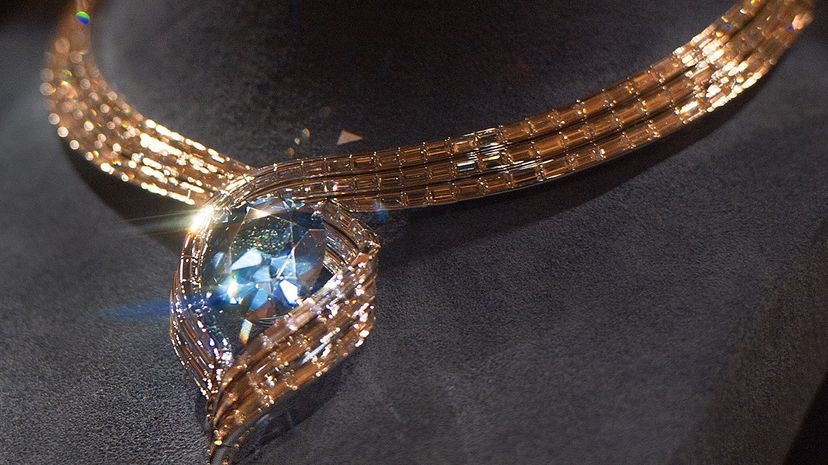 “The Hope diamond has passed through many hands in the years since it was created. Here, the diamond is displayed in a temporary setting, in the National Museum of Natural History. PAUL J. RICHARDS/AFP/Getty Images
“The Hope diamond has passed through many hands in the years since it was created. Here, the diamond is displayed in a temporary setting, in the National Museum of Natural History. PAUL J. RICHARDS/AFP/Getty Images
When you imagine the Hope diamond, a jewel that weighs more than 45 carats and is rumored to be cursed, what do you see? Perhaps a gem the size of a pumpkin that gives off an eerie, red glow, with ominous music in the background? Its spooky backstory of bad luck — which we’ll get to soon — kind of makes you wonder why anyone would want the thing in the first place, despite its opulence.
But as hosts Holly Frey and Tracy V. Wilson tell us in this two-part episode of Stuff You Missed in History Class, the Hope diamond’s size might not be as dramatic as you think. As Tracy puts it, bringing a kid to the Smithsonian National Museum of Natural History (where the jewel is housed) with the promise of seeing the biggest diamond ever might disappoint the child. "They will expect a diamond as big as their head, and the Hope Diamond is a diamond as big as a walnut," she explains.
At 25.6 millimeters (1 inch) long and 21.78 millimeters (0.86 inch) wide, the Hope diamond isn’t the largest diamond in the world. (That distinction belongs to the Cullinan I, a 530-carat gem cut from an even larger stone.) But with its distinct blue cast and the creepy stories that follow its ownership, it’s probably the most famous one.
But its fame isn’t exactly well-earned when it comes to the myths surrounding it. It’s claimed that an explorer took it from a Hindu temple and was subsequently cursed — and ripped apart by wolves — for stealing it. Others claim that Marie Antoinette sashayed through Versailles wearing it around her neck before that neck was unceremoniously disengaged from her head. But neither disturbing tale can be verified.
So how did the diamond take on such myths? The wife of one of the Hope diamond’s namesake owners (May Yohe, wife of Lord Francis Hope) and famous jeweler Pierre Cartier both possessed the diamond at times and told extravagant stories about the tragedy that befell those who wore or owned it. But there’s one little wrinkle.
"Both of these people, who seemed to be the two main sources of all these rumors, had a vested interest in telling a good story," Tracy says. Both of them were trying to offload the diamond and make a profit. So continuing a narrative about how interesting and mysterious the diamond’s history was? A good sales technique, perhaps, but one with little basis in reality.
Now, don’t think that all the stories are completely fabricated. Tracy and Holly have found a few tales of woe regarding Hope diamond owners, and people are still quite invested in believing the diamond’s curse is real. And the Smithsonian Institution can attest. "The museum actually continues to receive letters about the curse that blame the Hope diamond for basically any problem [the United States has] ever had," says Holly.
So put on your best jewels, and tune in to hear Tracy and Holly explain the Hope diamond’s origins, myths and even the science behind the red glow (it’s true!) that makes the diamond famous on this two-part episode of Stuff You Missed in History Class.
Now That’s Cool
Why is the Hope diamond blue? A scientific analysis of the gem collected atoms that confirmed the presence of boron, which gives the diamond its unique hue.














































